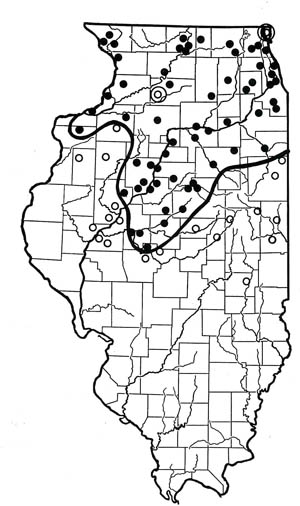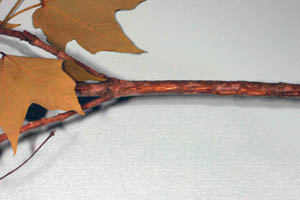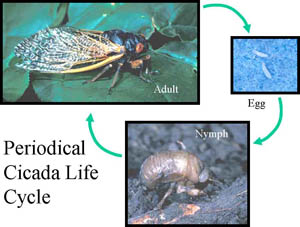Periodical Cicada | |
|---|---|
| September 25, 2006 | |
We are expecting a large emergence of periodical cicada in northern Illinois next spring. Cicadas are expected to emerge north of a line from northern Iroquois County on the east, dipping southward to northern Sangamon County in the center of the state, and then rising northward to the Moline and the other Quad Cities on the west. This is the Northern Illinois Brood, also known as Marlatt’s XIII brood. They last emerged 17 years ago, in 1990. Brown, 1-inch-long nymphs emerge from the soil in late May, climb up the trunks of trees and other vertical objects, and grab onto the bark; adults emerge from a split made along the back. Adults harden and darken into 1-1/2-inch-long black insects with red eyes. They have clear wings with orange veins. Males sing to attract females, filling the air with a wonderful trill or obnoxious noise, depending on your attitude. This brood has the reputation for the largest emergence of cicadas known anywhere. This is due to the size of the emergence and the research and subsequent reporting over the years by entomologists Monte Lloyd and Henry Dybas at the Field Museum in Chicago. During the 1956 emergence, they counted an average of 311 nymphal emergence holes per square yard of ground in a forested floodplain near Chicago. This translates to 1-1/2 million cicadas per acre. In upland sites, they recorded 27 emergence holes per square yard, translating to about 133,000 per acre. This number is more typical of emergence numbers but is still a tremendous number of insects. For comparison, a city block contains about 3-1/2 acres. When the cicadas start dying and dropping from the trees later in the spring, there are large numbers on the ground, and the odor from their rotting bodies is very noticeable. I have received reports from people in the Chicago area using snow shovels to clear their sidewalks of the dead cicadas in 1990. More will be written about the periodical cicada emergence next spring in this newsletter. The reason for this article is to warn against planting small trees in heavy-emergence areas this fall and next spring. After mating, the female cicadas use their ovipositor, or egg-laying device, to slice several inch-long crevices in twigs and branches to lay their eggs. They prefer twigs and branches from about 1/4 to 1-1/2 inches in diameter. The leaves past this damage typically wilt and die, and the twigs and branches commonly snap off in the wind. Small transplanted trees, particularly fruit trees, commonly have a trunk diameter small enough that egg slits are made in the trunk, resulting in the tree snapping off.  Insecticide applications kill huge numbers of visiting cicadas, but analysis of egg-slit trunk damage shows little difference between treated and untreated research plots. In fact, Fredric Miller found similar results in insecticide efficacy research conducted in the Chicago area in 1990. The only way to protect small trees from serious damage in a heavy emergence area is to protect the trunk with screening or other material. This is expensive in materials and labor. It is much better to delay small-tree planting for a year or install larger stock, preferably those with a trunk diameter of at least 2-1/2 inches. Emergence of periodical cicadas is not heavy in many areas, so tree planting can continue in those areas. These areas are very predictable. The memories of people living in particular areas during the 1990 emergence are very useful. Similarly, local newspaper accounts can be useful.  Some thought about periodical cicadas and their needs can also help. Realize that these insects require a steady supply of sap-supplying tree and shrub roots for 17 years. Housing developments in which all trees and shrubs were removed prior to building will have few cicadas because the nymphs died when the trees were removed. Similarly, housing developments in areas that were originally farm fields or prairie will have few cicadas due to the lack of trees. The practice of bulldozing all trees off of a housing development site has been common only since the 1960s, so older housing developments probably will have large numbers of cicadas. Another consideration is the long generation time of periodical cicadas. We are not used to thinking of insect life cycles longer than one year. Only nine generations of periodical cicadas ago, Abraham Lincoln was practicing law in Illinois prior to the Civil War. Periodical cicadas apparently move only about 1/2 mile during each emergence, so immigration into new areas is relatively slow. During the intervening time, periodical cicadas have probably spread only about 5 miles. Consider what northern Illinois was like before the 1900s. Large areas of prairie were present that had periodic prairie fires, which killed many trees. With prevailing west winds, large prairie fires would have moved east with the wind. Rivers that run roughly north to south, such as the Fox, Des Plaines, Illinois, Rock, and Mississippi Rivers would have functioned as firebreaks. Trees would have survived much longer on the east sides of these rivers, and so would the periodical cicadas. As a result, we see higher populations of periodical cicadas in East Peoria than in Peoria, Rockford east of the Rock River, and similarly along other rivers. Keep these in mind as you plan your tree-planting activities and look forward to this great biological event that will occur next spring. ( |